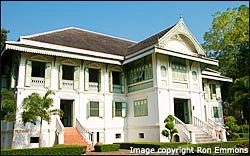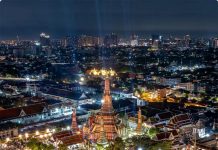The small town of Phrae, which sits on the banks of the Yom River about 200 kilometres east of Thailand’s northern capital of Chiang Mai, appears lost in time and almost completely unaffected by modern tourism. It retains part of its ancient walls and moat, within which visitors can find splendid examples of Lanna (northern Thai) temples, bustling markets and traditional culture.
Before entering the narrow lanes of the old town, a good place to get a sense of local friendliness and hospitality is at Chompooming Market on Muang Hit Road a few steps east of the intersection with Yantrakit Koson Road, the new town’s main road.

In the morning, this fresh market is crowded with shoppers. The appearance of a foreign visitor carrying a camera gets vendors joking that they will be “going abroad”. This does not mean they are ever likely to leave their native Thailand, but that the foreigner will be taking their images home overseas. Mounds of fresh fruit and chillis, plus the genuine smiles of the vendors, make for great images. Local delicacies such as red ants’ eggs, pork curry and rice noodles provide insight into the local diet.

Phrae’s only real claim to fame (apart from exquisite, though not widely acknowledged, architecture) is as the origin of mo hom shirts – the blue denim, collarless shirts that are worn by farmers and workers throughout the North. Visitors can watch the complex process of preparing the dye as well as the dyeing of garments at workshops in Thung Hong village, which straddles Route 101 a few kilometres northeast of the town centre. The liquid – a combination of the indigo plant, tamarind, lime and rice water – must be poured through the air in the morning and evening for several days to aerate it before it is ready for use as a dye. After dipping in the liquid, the cloth initially appears green before a reaction with oxygen in the air turns it blue. Apart from normal dyeing, patterns such as heart shapes can be created by clever tying of the garment before dyeing. All workshops have shirts, bags and purses for sale that make excellent souvenirs of a visit to Phrae.
During the late 19th century, Phrae was one of the main centres of the teak trade in the North. This legacy is easily seen today in some beautifully preserved wooden buildings once occupied by local rulers, as well as several temples that reflect a distinctive Burmese design influence. This might confuse some visitors, since Phrae is far from the Burmese border. The reason is simply that the Burmese, in particular the ethnic Shan, were skilled in teak extraction during the British colonial era, and many of them relocated to northern Thailand to apply their skills. As they became wealthy, they built temples as a way of making merit. Two of these, Wat Chom Sawan and Wat Sa Bo Kaew, stand out as being noticeably different in layout to typical Thai temples. Among their most distinctive features are ornate, multi-tiered roofs that soar skywards. The Buddha images that take pride of place in each temple are also fashioned in Burmese style.

Khum Chao Luang
Wongburi House Of the many teak houses scattered around the old town, the best preserved and most interesting are Khum Chao Luang and Wongburi House. Khum Chao Luang, built in 1892, was the residence of Phrae’s last independent ruler, Chao Luang Piriyatheppawong, and is looking magnificent after recent refurbishment. It is a pleasure to stroll across the cool, varnished floorboards and gaze at the period furnishings and faded photographs of the town’s past. In contrast to the pale green paintwork of this former royal residence, the pink and white exterior of Wongburi House makes it stand out among the surrounding vegetation. Once again, the interior is equipped with period furnishing, such as four-poster beds and a wind-up gramophone. It is easy to imagine its former occupants enjoying evening cocktails in its cosy corners.
Wat Luang There are also a couple of temples in the old town that are worth seeking out. Wat Luang is Phrae’s oldest and dates back to the city’s founding, as can be seen from the crumbling city gate beside the entrance. It has a very old Lanna-style stupa, as well as a tiny bot (chapel or ordination hall) with low-slung eaves, a colourful scripture library and a small museum that contains ancient Buddha images and various carvings.

Just a block further west, Wat Phra Non has recently been repainted with lashings of gold and red paint, making it very photogenic. The 300-year-old temple also houses a scripture library on stilts, and its main Buddha image, a large reclining Buddha that gives the temple its name, is housed in a small viharn behind the bot. Both buildings allow light in through a series of narrowly spaced slits in the wall instead of windows – a typical feature of Lanna-style temples.
A fine place to end this brief exploration of Phrae is at Wat Phra That Cho Hae, which sits on a small hill just nine kilometres southeast of the town. Though rarely visited by foreign tourists, it is the most important temple in the region. It is therefore almost always busy with devotees walking round the golden stupa before offering flowers, incense and candles at its base. The temple’s viharn is an unusual crucifix shape, and its whitewashed walls are decorated with floating thewada (angels) and light-coloured glass mosaics. While looking at the temple’s attractive decorations, listening to the tinkle of coins in metal bowls dropped by devotees and feeling a cooling breeze waft over the hill, it’s easy to sense the kind of contentment that has helped to unify Lanna culture throughout the centuries.

Note: A good way to explore Phrae is by tricycle. The Mae Yom Palace Hotel (Tel: +66 (0) 5452 1028-34) or Mr Songkran Luangkao, President of Phrae Tricycle Club (Tel: +66 (0) 8 1673 9841) can organize tours of the main sights lasting up to three hours and costing 250-300 baht.
ABOUT THE AUTHOR
Ron Emmons is a British writer/photographer based in Chiang Mai. He is the author of Portrait of Thailand (New Holland) and has contributed to several guidebooks on Thailand, including Frommer’s Thailand and Top Ten Bangkok (DK Books). Ron also writes stories on travel and culture for a variety of international publications, such as Sawasdee (Thai International inflight) and the South China Morning Post.




